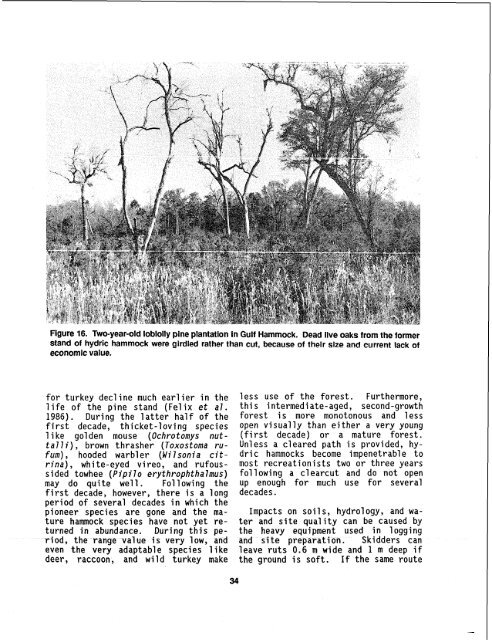a Guide to Management - USGS National Wetlands Research Center
a Guide to Management - USGS National Wetlands Research Center
a Guide to Management - USGS National Wetlands Research Center
Create successful ePaper yourself
Turn your PDF publications into a flip-book with our unique Google optimized e-Paper software.
Figure 16. Two-year-old loblolly pine plantation in Gulf Hammock. Dead live oaks from the former<br />
stand of hydric hammock were girdled rather than cut, because of their size and current lack of<br />
economic value.<br />
for turkey decline much earlier in the<br />
life of the pine stand (Felix et a7.<br />
1986). During the latter half of the<br />
first decade, thicket-loving species<br />
1 i ke go1 den mouse (Ochro<strong>to</strong>mys nut -<br />
ta77i), brown thrasher (Toxos<strong>to</strong>ma ru-<br />
fum) , hooded warbler (Wi7sonia cit-<br />
rina), whi te-eyed vireo, and rufous-<br />
sided <strong>to</strong>whee (Pipi70 erythrophtha7mus)<br />
may do quite well. Following the<br />
first decade, however, there is a long<br />
period of several decades in which the<br />
pioneer species are gone and the ma-<br />
ture hammock species have not yet re-<br />
turned in abundance. During this pe-<br />
riod, the range value is very low, and<br />
even the very adaptable species like<br />
deer, raccoon, and wild turkey make<br />
less use of the forest. Furthermore,<br />
this intermedi ate-aged, second-growth<br />
forest is more mono<strong>to</strong>nous and less<br />
open visually than either a very young<br />
(first decade) or a mature forest.<br />
Unless a cleared path is provided, hy-<br />
dri c hammocks become impenetrable <strong>to</strong><br />
most recreationists two or three years<br />
following a clearcut and do not open<br />
up enough for much use for several<br />
decades.<br />
Impacts on soils, hydrology, and wa-<br />
ter and site qua1 ity can be caused by<br />
the heavy equipment used in logging<br />
and site preparation. Skidders can<br />
leave ruts 0.6 m wide and 1 m deep if<br />
the ground is soft. If the same route

















